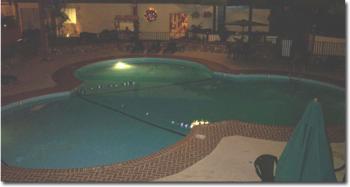October 1, 2016 Hotel Pool is Scene of Incident Involving High School Track Team Member
Biggins v. Overland Hospitality

On May 30, 1997, 17-year-old David Biggins had been swimming and playing in the indoor swimming pool at the Holiday Inn at 1612 No. Providence in Columbia, Missouri. David was visiting the hotel with other members of his high school track team who were in Columbia for a regional track meet.
Based on various witness statements, there were between 40 – 150 people in the swimming pool and/or surrounding area. The swimming pool area was dark and the water was extremely cloudy and turbid.
Prior to his submersion, one of his friends, Patricia, had observed David bobbing, but she thought he was playing in the water. Some time later, when she started to dive into the water in the deep end, she observed David lying on the bottom of the pool. Patricia then alerted another friend, Wiley who was able to dive down and bring David to the surface. David was then removed from the water at which time patrons initiated resuscitative efforts.
One of the hotel employees saw the victim’s Coach and other track members pulling David from the swimming pool and then he radioed the front desk instructing them to call 911 because of a drowning incident at the swimming pool. Fire and EMS were dispatched to a possible drowning at the Holiday Inn at 9:18 p.m. and arrived on the scene at 9:24 p.m.
David was transported to the nearest trauma center and was pronounced dead at the hospital.
Breaches in the Standard of Care
The following breaches were identified during this Expert’s investigation of the drowning incident that contributed to the death of David Biggins.:
- Failure to train a Certified Pool Operator.
- Failure to have a Certified Pool Operator on site.
- Failure to train hotel personnel in principles of safe swimming pool operations and management.
- Failure to provide a lifeguard and/or attendant to supervise the swimming pool and the surrounding area during high occupancy periods
- Failure to eliminate and/or minimize the dangers through the implementation of a comprehensive Risk Management program and the conduct of a Threat Analysis.
- Failure to conduct a Threat Analysis of the facility to determine:
- the physical hazards that exist in and around the swimming pool; and
- those activities that place guests at increased risk
- Failure to warn of the hazards, risks, and dangers associated with the swimming pool.
- Failure to post appropriate and effective signage.
- Failure to educate hotel guests regarding the hazards, risks and dangers associated with the swimming pool.
- Failure to separate the shallow from deep end of the pool with a lifeline.
- Failure to separate the shallow from the deep end of the pool with a depth line.
- Failure to establish facility-use guidelines for outside groups using the swimming pool facility.
- Failure to require supervision and accountability of groups and their participants.
- Failure to implement a passive monitoring system of the swimming pool and surrounding area.
- Failure to regularly monitor the swimming pool and the surrounding area.
- Failure to implement a passive monitoring system of the swimming pool and surrounding area.
- Failure to regularly monitor the swimming pool and the surrounding area.
- Failure to establish a bather load for the swimming pool.
- Failure to enforce a bather load for the swimming pool.
- Failure to train hotel personnel as first responders to respond to medical emergencies in and around the hotel property.
- Failure to provide trained first responder personnel to respond to medical emergencies in and around the swimming pool.
- Failure to provide resuscitation equipment for effective response to respiratory and/or cardiac emergencies.
- Positive Pressure Ventilation Devices
- Personal resuscitation mask or shield
- Bag-valve-mask resuscitators
- Airway Management Devices
- Manual hand-held suction device
- Oxygen Administration Equipment
- Automated External Defibrillator (AED)
- Airway Management Devices
- Positive Pressure Ventilation Devices
- Failure to assess the condition of the water regularly throughout the day.
- Failure to take corrective action to remedy cloudy and/or turbid water.
- Failure to close the swimming pool when the water was cloudy and/or turbid.
- Failure to monitor the activities in and around the swimming pool and to provide controls/supervision for teenagers using the swimming pool.
- Failure to assess the lighting in and around the swimming pool to assure safety of all guests using the swimming pool.


